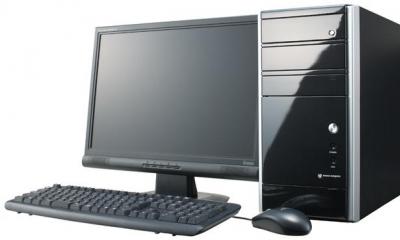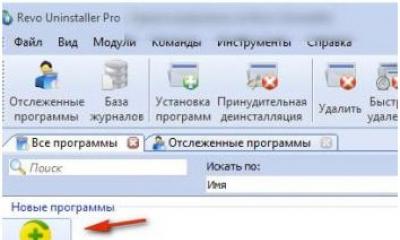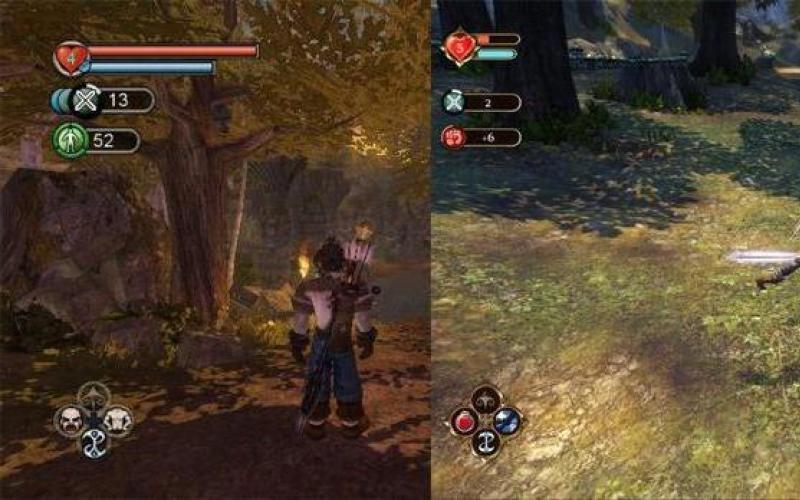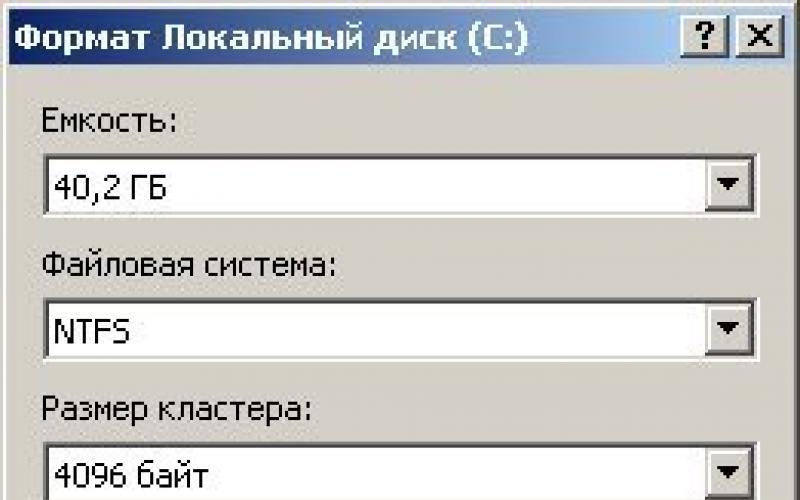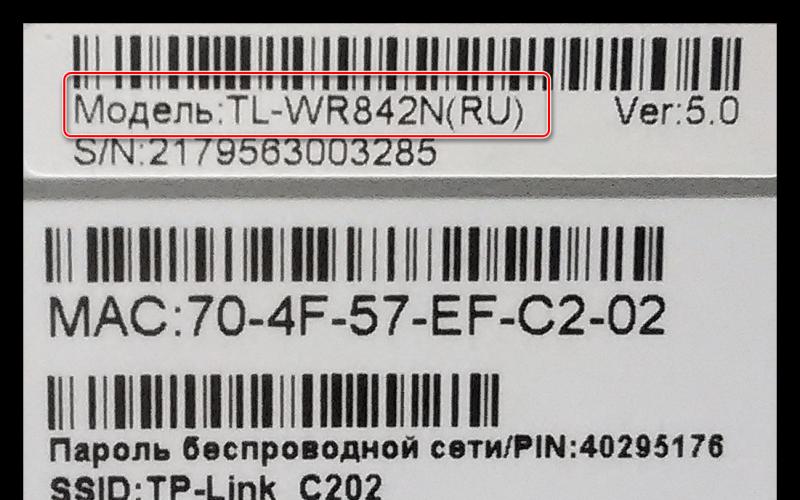Some time after installing the operating system, situations may arise when the computer begins to work noticeably slower than before. This may be due to the performance of individual programs or games, or a drop in performance in general.
There are several reasons leading to this effect; they should be divided into two large groups.
- The hardware cannot cope with the increased load. For example, a new computer game or an installed editor for creating animation requires large resources. This problem can be solved by hardware improvements (replacing the video card, CPU, increasing the size RAM), and by increasing performance using special utilities to “overclock” the system. In the latter case, it is possible to use standard settings through the menu “ BIOS Setup».
- During the operation of the operating system, a fair amount of “garbage” has accumulated on the hard drive, too many programs are running in the background, Windows registry needs cleaning. All this can greatly slow down work.

SiSoftware Sandra Lite program for system analysis
To initially determine the performance of the system, a small program called SiSoftware Sandra Lite is useful; in addition to the commercial version, a lightweight, free version is available. It is quite enough for a general assessment.

The same actions can be done with all elements of the computer. The data obtained will help determine further steps to optimize your computer.
There are several solutions to speed up your PC.

Advice! If there is insufficient RAM, upgrading other components may not have much effect. Therefore, you should start improving your PC with it. Before increasing the memory capacity, you must ensure that the RAM limit for a given motherboard is not exceeded, otherwise the excess memory will not be available to the system.
The search for the part “to blame” for the sluggishness is carried out by comparing the recommended system requirements software developers with real characteristics of the component.
During the modernization, do not forget about physical cleaning system unit. Dust that accumulates for years on PC boards and heatsinks, inside the power supply, does not in the best possible way affects performance, so it needs to be removed.

We clean the system unit from dust using any available method.
Another additional method is to “overclock” the processor (or video card). The fact is that the factory settings of the motherboard assume a safety margin of at least 15-20% for the clock frequency of the system bus. This is done to ensure system stability.
Most CPUs easily overclock by up to 20%, this is a noticeable increase even when the OS is loaded.
The easiest way is to increase the clock frequency using utilities; most motherboard and video card manufacturers provide them along with drivers or post them on official websites.

To “overclock” video cards and motherboards, special utilities created by their manufacturers are used
But the fact is that the settings will only work after loading the OS, and some systems (for example, Linux, *BSD) are not supported by the utilities.
Attention! Applying settings related to changes in clock speeds and CPU multiplier may result in system inoperability.
Adjusting the BIOS Setup settings will allow you to immediately evaluate the changes that have occurred: for example, the system will boot faster.
Advice! For stable operation of a PC with an increased CPU clock frequency, more efficient cooling may be required: replacing the radiator and cooler with more powerful ones or introducing a liquid cooling system, the most advanced at the moment.

In this case, you need to reduce the operating frequency of the RAM to avoid errors.
Advice! If after another change parameters, the computer stops turning on, you need to turn off the power to the PC system unit, remove the battery that powers the BIOS chip, it is located on the motherboard, and put it back in place. After this, the settings will be reset to factory settings.

To reset the settings to factory settings, remove the battery that powers the BIOS chip on the motherboard and insert it back
Important! It is strictly not recommended to disable CPU thermal protection in the BIOS settings. If it overheats, it may fail. If you are not sure of the correctness of your actions, then the most reliable way is to use utilities in Windows.
Acceleration of video cards occurs using appropriate software. For example, NVidia cards can be overclocked using the Nvidia Inspector program.
To overclock a video card using Nvidia Inspector:

Asus devices on Nvidia chips are similarly “overclocked” using the GPUTweak utility.

GPUTweak utility interface
Five ways to increase PC performance
Method 1

You can open the “Services” tab in the same “msconfig” utility. Here is a list system services, which run simultaneously with the system and occupy RAM.

In the “Open” field, enter the command “msconfig”, press “Enter”

Open the “Services” tab
In order to avoid problems with disabling system programs and prevent unstable operation of the OS, it is recommended to check the “Do not display Microsoft services” checkbox.

We check the box “Do not display Microsoft services”, check the boxes for the services that we do not need, click the “Disable all” button
Some of the remaining services can be disabled. For example, the Remote Registry service, which usually runs by default, is not needed. Some installed programs They can also register their own services in “Services.” You need to understand in detail which of them can be safely disabled.
An incomplete list of services that you can safely disable:
- print manager if the printer is not in use;
- Tablet PC input service;
- Windows Media Center Scheduler;
- Bluetooth support;
- Windows Search;
- Remote Desktop Services;
- Windows archiving.
A more complete list of services that can be deactivated can be easily found on the Internet.

Services that can be disabled on Windows 10
We set the optimal size of the paging file. This is hard disk space reserved by the system for temporary storage of files, to help RAM when its size is insufficient. That is, this is a kind of addition to the OP.

Selecting a Specific Value virtual memory in modern PCs depends on the maximum load of running programs.
It's easy to find out:

Note! It is best to set a certain average value, selected experimentally, as both a minimum and a maximum. A fixed size is more convenient, since the hard disk space will be strictly reserved by the system.

Defragmentation of the hard drive. During system operation, files are distributed in pieces throughout the entire hard disk space (fragmented). Reading them slows down as a result of the magnetic head of the hard drive (HDD) wandering along the surface of the disk. To optimize the work, you need to overwrite the files and collect them in order. This is called defragmentation.
If possible, it is better to use the Diskeeper program; it is paid, but there is a trial version.
The standard Windows defragmenter is activated from the “My Computer” window.

The system will analyze the disk and defragment it if necessary. Repeat the action with the remaining logical drives.
Advice! When reinstalling the OS, you need to create at least two logical drives: for the system and for other data (programs, documents, videos, etc.).
Using ReadyBoost technology. Windows supports the use of flash drives to speed up the system. On low-power and medium-sized PCs it gives some performance increase. Especially with many tabs or windows open in the browser in Windows, loading speeds up slightly.

Using flash drive memory to increase PC performance with ReadyBoost
The way ReadyBoost works is that the flash drive begins to work as an intermediary between the RAM and the hard drive. Part of the OP cache is reset to flash memory, and due to the fact that the data exchange between the solid-state drive and the OP is higher than in the OP-hard drive connection, faster data exchange is obtained.
But flash memory has a limited number of read-write cycles, so it will last less in this mode than in normal mode.
There are restrictions:
- For file system Fat32 – up to 4 GB of memory can be used;
- in NTFS – up to 32 GB;
- In total, up to 256 GB (8x32 GB) can be used for ReadyBoost mode.

The three most popular programs for removing garbage, filtering the registry, removing programs that cannot be removed using regular tools, searching for duplicates of various files and other functions.
| Program | Functions | Terms of distribution | Language |
|---|---|---|---|
| CCleaner | Removing programs. Cleaning the registry. Deleting temporary files. Securely erase disks. Managing Browser Add-ons | Shareware | Russian |
| Advanced System Care | Removal malware. Speed up your Internet connection. System optimization. Cleaning the registry. | Paid | Russian |
| Wise Registry Cleaner | Deleting files. Defragmentation, elimination of registry errors. System optimization | Shareware | Russian |
There are two simple ways turn off, restart or sleep your PC.

Note! Where 300 is the time in seconds. After 5 minutes the computer will turn off.
The second method involves writing an entire script.

You can use the following switches (put them instead of /s):

- Metro applications take up space on your hard drive, and their functionality is questionable.
- Software installed along with drivers. For example, laptops are often sold already with an OS, most additional programs You can safely remove them from the manufacturers.
- Internet Explorer is not needed. There are many browsers to suit every taste.
- Windows Media Player is not needed. There is K-Lite Codec Pack for watching movies and a lot of players for listening to music.
- Windows Games. They also take up space.
Too low frames per second (FPS) can be caused by either excessive system load or outdated PC components.

Excessively high system load, or outdated PC components affect the quality of FPS in computer games Oh
Before you start replacing components, it is recommended to try the following methods:
- close all other programs, including those running in the background;
- update video card drivers;
- try experimenting with the settings of the video card and the settings of the game itself.
Sometimes games downloaded from suspicious sources may not work correctly. Licensed editions must be purchased.
Read useful information in the article - “How to clean your computer so that it doesn’t slow down.”
If all else fails, then it's time to think about upgrading your video system.
Hello friends. Well, we probably all try to get the most out of our computers. I want it to work as quickly as possible, websites open faster, programs and games run faster. And we probably all get angry when the page scrolls jerkily, tabs in the browser switch with a delay, and programs open for a couple of minutes.
You will probably say: “Well, you are behind the times, there are no such computers anymore, but on modern ones everything flies.” Maybe, but still we are almost always not satisfied with the speed of our computer and we always want something more. And so I decided to write an article about how to speed up your computer, I have already written a similar article, but in today’s article I would like to talk in more detail about how to overclock a computer, not only using software, but also by overclocking the processor and replacing some components. Let’s start, in my opinion, with the most effective method.
Add RAM - set the speed
This is advice from my own experience. I have seen many times how when adding RAM, the speed of the computer increased significantly. I used to have 512 MB of RAM, I wasn’t very keen on computers back then and it was enough for me, well, it was enough, Windows XP worked, although it didn’t fly. But when I realized that something needed to change, I bought another 1 GB stick of RAM. The increase in speed was very large. Now Windows 7 works well on this computer.
So if you don’t have a lot of RAM on your computer, say 512 MB or 1 GB, then it makes sense to increase it, especially since it is not very expensive. I understand that new computers are probably no longer built with this size of RAM, but there are still many old computers that have the right to a second life. And in this way speed up old computer can be very effective.
Install a new video card and release the integrated one
Another good way To make your computer run faster is to install a new video card. The fact is that old computers, and not very old but budget ones, usually work with an integrated video system. In this case, the graphics processing load falls on the central processor, and this slows down the entire operation of the computer, and you won’t be able to play normal games. Therefore, this problem can be solved by installing a second video card. You can install even an inexpensive one, around 300-400 UAH. (1200 – 1700 rubles)
Overclock the processor
Just take it and overclock it, but be careful :). I was debating whether to write this here or not, but I decided to write it anyway. I have a processor now Intel Celeron, don't laugh :). Its standard frequency is 1600 MHz, but for about more than a year now I’ve had it overclocked by 10 percent, it was 15 percent. Now it operates at a frequency of 1760.0 MHz, here is a screenshot from Everest.
 I overclocked it using, or rather increasing the system bus frequency in the BIOS menu. It was not possible to overclock it by more than 15%. After I increased the system bus frequency by several points, the computer simply did not start. I had to reset the BIOS settings, shorted the contacts on the motherboard, and then did not overclock it by more than 15%. There you can do more, but you need to increase the voltage on the processor. But since my computer can be said to be an office one, I didn’t find such an item in the BIOS.
I overclocked it using, or rather increasing the system bus frequency in the BIOS menu. It was not possible to overclock it by more than 15%. After I increased the system bus frequency by several points, the computer simply did not start. I had to reset the BIOS settings, shorted the contacts on the motherboard, and then did not overclock it by more than 15%. There you can do more, but you need to increase the voltage on the processor. But since my computer can be said to be an office one, I didn’t find such an item in the BIOS.
Although it was a long time ago, I need to try again. I may write about this in a separate article, subscribe to RSS. I forgot to mention the gain from overclocking the processor. Well, I didn’t notice a strong increase in the speed of work, but it seems to work faster.
Be careful, or better yet, don't do anything like that. And if you do, it is at your own peril and risk. It is possible to turn the processor into a brick.
Software to help
Don't ignore and software that can speed up your computer. Don’t forget about defragmentation, cleaning up debris, etc. I wrote about all this in the article linked above.
You can write a lot more about how to speed up your computer, but I have chosen the most economical tips for you. And one more piece of advice, love your computer, don’t clutter it with all sorts of rubbish, because if you use your computer somehow, install everything in a row, then no powerful hardware will help you. Good luck!
Speeding up your PC may be needed for a variety of reasons. Some users are thinking about how to overclock their computer because there is not enough power for gaming, while others simply want to achieve maximum performance. For outdated equipment, overclocking is practically the only way to extend its service life.
People started thinking about how to overclock a computer at the same time as its appearance. In 8088 processors with a clock frequency of 8 MHz, radio amateurs replaced the clock generator, after which it could run at a frequency of 12 MHz, which means 50% faster. In modern computers, the overclocking process is much easier; it can be done by changing the BIOS settings.
There is also a corresponding software, which allows you to speed up your computer components directly from the Windows environment. The solution to how to overclock an old computer lies in changing the position of special jumpers (switches) on the motherboard.
Determining computer settings
Overclocking RAM

The performance of a computer is affected by both the amount of installed RAM and the speed of its operation. The speed is set by timings, which reflect the execution of operations in nanoseconds. Accordingly, the lower the timings, the higher the memory performance. The speed of data exchange is also affected by the frequency of the system bus: the higher it is, the more operations can be performed per second.
Solutions to how to overclock a computer's RAM are divided into two directions: through the BIOS or software, you can try to lower the memory timings. But success in this case can be achieved if the modules are designed by the manufacturer for low values or when they are set in automatic mode in the BIOS.
Programs for overclocking RAM
Most programs clean and optimize RAM. But there are also those that allow you to make changes directly from the Windows environment. These include RamSmash, Turbo Memory, MemMonster and some others. In addition to changing memory settings, they allow you to control its physical parameters, which greatly simplifies overclocking.
An increase in memory frequency usually occurs when the processor is overclocked, but in this case the timings have to be increased in order to achieve stable operation of the modules. It must be kept in mind that as the memory operating frequency increases, the heat dissipation also increases. Therefore, you need to take care of cooling by installing radiators or more powerful fans in the system unit.
Overclocking a video card

How to overclock your computer to maximum? In this case, you cannot do without speeding up the video card. To do this, use various applications supplied by manufacturers or third-party developers. Modern video cards slightly inferior in performance to the processor and motherboard.
They also have a central processor, video memory and an internal data bus. Therefore, they overclock both the graphics processor and increase the frequency of the video memory. To ensure stable operation, it may be necessary to replace the standard cooling system with a more powerful one.
Software overclocking of video cards
The manufacturer provides RivaTuner software for overclocking nVidia cards. For Radeon family cards there is also an application supplied by the developer - AMD Catalyst. But there are many other programs that allow you to evaluate the performance of a specific video card and reveal its potential.
The fact is that manufacturers often use the same chip, but on lower models the clock speed and some graphics processing functions are cut. Such programs include GF123clk, NVMax, Raid-on Tuner, PowerStrip. They allow you to configure graphics processing parameters and smoothly increase the frequency of the processor and memory.
Speeding up your hard drive

Before you overclock your computer for gaming, you should understand that performance is of utmost importance. hard drive. Modern games actively load and exchange data with the disk, so slow hard drive can become a bottleneck in computer performance.
The speed of drives with a spinning disk is much lower than the speed of data transfer and processing by RAM and processor. Good decision is the installation of a solid-state drive (SSD) into the system. It is capable of speeding up data loading and unloading by 2-3 times. At the same time, prices for these devices continue to decline as production volumes increase.
Speed up your Internet experience
One solution to how to overclock your computer in a safe way is to speed up your Internet browsing. Recently, more and more applications and games work online, so this task is becoming more and more urgent. Browser optimization and network connection settings are used to speed things up.
You can manually change browser settings and connection parameters if you have the appropriate knowledge and experience. Special applications to speed up the Internet come to the aid of ordinary users. The most common of them include:
- Ashampoo Internet Accelerator;
- SpeedyFox;
- Speed Connect;
- Active Speed;
- cFosSpeed.
Computer overclocking control
Of great importance for how to properly overclock a computer is constant monitoring of the parameters of all components related to overclocking. This is achieved through monitoring in the BIOS, as well as using special applications. The most advanced of them provide comprehensive information about the temperature, supply voltage, and fan speed of all system components.
It is not enough to know how to overclock a computer; you also need to determine the stability of its operation under load. Such functions are also available in many programs. To do this, either complex mathematical functions or playing excerpts from computer games are used. The most popular include the following:
- CPU-Z;
- 3DMark;
- AIDA 64;
- PCMark
Many motherboard manufacturers complete their products with appropriate programs for monitoring physical parameters.
Applications for general overclocking of a computer
One of the best solutions on how to overclock your computer in a safe way is to use utilities to clean and optimize your computer. They can both clean and customize operating system, and make changes to the settings of components to increase their performance.
The disadvantages of such complex programs include the high duration of their work. But this is explained by the fact that a scrupulous analysis of all components of the system is carried out, and some operations, such as defragmenting a hard drive, take a long time.
But as a result of such programs, you can get a significant increase in productivity without making changes to the operation of the equipment. And changes that cause components to operate abnormally will, in any case, reduce their service life. The most famous comprehensive utilities include AVG PC Tuneup, Ashampoo Win Optimizer, Glary Utilities and many others.
I am sure that users of not the most productive systems, the so-called “home” computers, have more than once dreamed of at least a small increase in the power of their computers, even if just a little, but bringing them (computers) closer to more serious “gaming” machines or simply more nimble brothers . Many have justifiably resorted to computer optimization for these purposes, but this is not all that can be done, because there are two more ways to achieve this goal.
The first is to purchase a more powerful computer and/or some of it. It is clear that this method is not suitable for everyone. Firstly, in financial terms - not everyone will go to buy or at a price equal to his salary, and there are also those for whom it is simply morally difficult to pay 10,000 rubles for a piece of hardware the size of a matchbox. Secondly, technological progress does not stand still and maybe once every six months another new product appears on the market, which immediately becomes a “must”, because you always want faster, higher, stronger and all that. The second method is the so-called “overclocking” of computer components, be it a processor, a video card or something else.
This very thing will be discussed in this material (by the way, we are opening a whole section “Computer Overclocking” in which articles on relevant topics will regularly appear).
Well, let's go.
General information about the computer overclocking process: principles and facts
The purpose of the article is to try to clearly explain to the reader the essence of overclocking and its principles. Specific examples of this process will not be described here, but only the main methods and necessary characteristics of components that affect computer performance.
So, first of all, overclocking is the operation of individual devices or the computer as a whole in abnormal (often extreme) modes.
Undoubtedly, the main reason for overclocking is to increase system performance, which is quite significant with a skillful and thoughtful approach. This way you can save some money on purchasing new and more expensive computer components.
The main disadvantages of overclocking include a reduction in service life and the risk of failure of the overclocked device due to insufficient cooling or operation at an excessively high frequency. It is also worth mentioning the warranty - it does not apply to a device that burns out during overclocking, since the manufacturer does not guarantee stable operation with characteristics exceeding the rated values (even if a utility supplied by the manufacturer is used for this). On the other hand, the fact of overclocking is difficult to prove, so you can still try to get away with the phrase “It burned out on its own!” in the store.
Before moving directly to the topic of the conversation, it would be useful to take into account two more important points:
- The result of overclocking computer devices is an increase in the heat they generate. First of all, you should take care of cooling. The minimum action to take is to thoroughly clean the radiators of the processor and video card coolers, preferably with a fresh one if possible. It would also be a good idea to install additional fans in the system unit to remove excess heat.
- For greater reliability, you can replace the main elements of the cooling system - purchase a new, more efficient one for the central processor, radiators for. As a last resort, install a water cooling system (water cooling system).
Overclocking also directly affects power consumption. must have a sufficient power reserve, otherwise voltage drops and other terrible disasters are inevitable.
And now about the main thing.
Let's start with the fact that not all computer components can be overclocked, some simply cannot be overclocked at home, some do not make sense to “drive” at all (for example, a sound card, respectively). The main “overclocking” components are the processor, video card and RAM. Let's talk briefly about each of them from an overclocking point of view.
Processor.
As many people know, it is the “brain” of the computer; it is responsible for data processing functions, and the performance of the entire system directly depends on its performance. The most important characteristic is the frequency (CPU frequency). It is this that needs to be increased to increase productivity. Overclocking is carried out either by changing the settings in, or by specialized programs. As for me, the first method is the normal one.
The final processor frequency (i.e., what is indicated in the price lists, displayed when loading or in any programs showing data about the computer, etc.) is calculated using the formula “frequency = base frequency * processor multiplier” (hereinafter under the base frequency this means “Bus Frequency” (FSB - Front Side Bus), i.e. these terms mean the same thing, although they are “shuffled” during the text). A few words about each element of the equation:
- The base frequency is set by a specialized microcircuit - a clock pulse generator, located on the board, i.e. each motherboard has an item "FSB frequency" in the characteristics
- The processor multiplier (the so-called multiplication factor) is a characteristic of the processor, namely, the number by which the value of the base frequency is multiplied, as a result of which the final frequency is calculated, so to speak. However, in almost all modern processors it (the multiplier) is locked by the manufacturer or set to the maximum value, so when overclocking we can only change the bus frequency.
For example, with a base frequency of 200 MHz and a multiplication factor of 10, the final processor frequency is 2000 MHz (2 GHz), which is indicated in the price lists. By going into the BIOS and increasing the bus frequency from 200 MHz to 220 MHz, you can get a 2200 MHz “processor” frequency. Well, and so on until we hit the ceiling, at which stability ends and the computer begins to start or even fails to start.
It should be noted here that not only the performance of the processor, but also the other devices of the computer depends on the value of the FSB frequency (that is, this same Basic frequency). This means that a moment may come when, at a certain value, some device may refuse to work. This should also be taken into account when overclocking.
Video cards.
They have their own BIOS, therefore they are almost independent of the settings that we specify for the motherboard, that is, they cannot be overclocked through it. The cards themselves are overclocked by specialized programs, either supplied by the manufacturer and included in the package, or, so to speak, third-party, that is, developed by someone else.
The principle of overclocking is the same as for the processor - a gradual increase in the frequency of the graphics chip and memory by ten megahertz, then, if the test is successful, the whole procedure is repeated. The goal is a rough search for the maximum frequencies at which the video card operates without failures. Signs of failures are image artifacts - “dropping out” of pixels on the screen, extraneous stripes, color changes, etc., i.e., if this begins to appear when the video card is running, then it is enough to return to the previous stable frequencies and consider overclocking the card to be complete.
The test is carried out using programs designed for this purpose or on your favorite games. What is typical is that at these stages of overclocking, a short check of the video card is enough, up to 10 minutes in the same game, in order to identify the presence of the above-mentioned artifacts, while looking at , because this temperature (as well as the temperature of other elements during their overclocking) increases simultaneously with increasing your frequencies, therefore it is recommended to carefully monitor it. If the video card temperature is around 70 degrees, then you should think about it. If this is not possible, it is better to stop overclocking and return to standard frequency values (which should be recorded first, and in general, it is advisable to keep records of each step).
At this stage, preliminary overclocking ends (i.e., as written above, a rough search for frequencies) and a more precise one begins.
The principle of this stage is to change frequencies by 1-2 MHz, followed by testing after each change. The goal is to find the absolute (maximum) frequencies at which the operation of the video card remains stable.
The stability check at this stage is deeper and longer than the 10 minutes of a rough frequency search. Often, in this case, they recommend an overnight test in a game that can play demo scenes using its own engine, rather than a video. If in the morning the computer does not freeze, does not reboot, and there are no changes in the image, then overclocking can be considered successful.
RAM.
The most common options for overclocking RAM are increasing its frequency and decreasing it.
The memory frequency depends on the value of the same base frequency, since RAM also has its own multiplication factor (on some motherboards it is possible to change it).
That is, as mentioned above, by increasing the base frequency you can increase not only the frequency of the processor, but also the RAM, which usually happens (by the way, often overclocking a processor, as they say, “rests” on the memory, i.e. it is already cannot operate at a given bus frequency, but the processor still has some headroom, so special overclocking enthusiasts even change the memory to unlock the overclocking potential of the processor).
And if everything is clear with frequency, then with frequency the situation is more complicated.
To access a memory cell, the controller performs several requests - it sets the number of the so-called bank, the page number in it, the row number and the column number. Timing is precisely the time to complete each operation, not only those indicated, but the rest as well. There are quite a few of these same timings, but when overclocking the following are usually used:
- the delay between the submission of the row number and the column number, called the full access time (RAS to CAS delay);
- the delay between submitting the column number and receiving the contents of the cell, called the duty cycle time (CAS delay);
- delay between reading the last cell and submitting the number new line(eng. RAS precharge).
The unit of measurement for timings is a nanosecond and, naturally, the smaller it is, the faster the operation is performed.
It is impossible to simultaneously increase the frequency and reduce the RAM timings. Here you have to choose either the “golden mean” (increased the frequency a little, slightly lowered the timings), or one thing or the other. The simple fact is that if the frequency increases significantly, then the timings will have to be left as standard, and in some cases they even need to be increased for stability purposes. And vice versa, by reducing the timings, you may have to tighten the frequency. It is impossible to say unequivocally which of these is more important, but I am a supporter of frequency overclocking.
Afterword
That's how things are.
Thus, by gradually “overclocking” the computer, or rather each of its important components, you can achieve some increase in performance, sometimes even quite significant, because, for example, your humble servant sysadmin overclocked his processor by 50%, i.e. 2.4 to 3.6 Ghz, and this, firstly, to put it mildly, is a good increase in performance, and secondly, it saves a couple of thousand than when buying a processor with a similar frequency already installed.
Something like that. As always, if you have any questions, additions, thanks, etc., please write in the comments to this article.
In the next material in this section, we will look at a specific example, tools and overclocking techniques. I don’t know where we’ll start yet, but most likely, with everyone’s favorite processor.
PS: For the existence of this article, special thanks to a friend of the project and a member of our team under the nickname “Sinclair”.
Overclocking options for a HYPERPC computer
We offer two levels (stages) of professional computer overclocking, with a guarantee of stability and reliability of the entire system.
| HYPERPC Overclock Standard Package | HYPERPC Overclock Plus Package | HYPERPC Overclock Premium Package | Other companies | |
|---|---|---|---|---|
| Overclocking level | Overclocking Stage 0 | Overclocking Stage 1 | Stage 2 overclocking | |
| Overclocking the processor while maintaining the warranty | Absent | +200Mhz | +300Mhz | Absent |
| Selecting a processor with good overclocking potential | Absent | |||
| Replacing the thermal interface with liquid metal | Not available / paid |
We offer processor overclocking with a 100% guarantee of stability and reliability of the entire system.
Processor overclocking is carried out by professional staff with extensive experience. Three-day PC testing in serious tests to fully check the entire system. Maintaining a full warranty on all components of the system unit. Guaranteed 100% stability and reliability of our overclocked systems.
The performance of modern processors would have seemed amazing five years ago, but today it may not be enough for the tasks that users face.

Speed up your computer
For the latest games, video editing, 3D design and other applications, the speed of the main computing unit in a computer is never enough. Of course, the easiest way to increase it is to purchase an older, faster model. But, firstly, this requires a lot of money, and secondly, sometimes it happens that a faster model simply does not exist. There is another way to speed up the processor - overclocking it.

What is needed for successful overclocking?
For successful overclocking, it is necessary to find the optimal ratio of a stable clock frequency, the voltage required for it and the permissible heating of the CPU. This leads to the first requirement that must be met: high-quality cooling. This is the main factor influencing the result.
Any manufacturer builds a safety margin into their products to ensure the devices operate even in adverse conditions. Processors are no exception: the vast majority of models are able to operate without problems at a clock frequency exceeding the nominal by at least a quarter.
Considering that most often processors with such a difference in frequency are much more expensive, the benefit is obvious. Let's consider how you can achieve it. The main factor that affects the stability of the CPU is temperature. Increasing the processor frequency increases the temperature rise, which in turn causes processor instability.

How we do it
Fortunately, modern processors are protected from overheating, and if a safe threshold is exceeded, they either go into slow mode until they return to the “green zone”, or turn off. To get a good increase in frequency, we install only high-quality coolers (we also don’t forget about good thermal paste). We also assemble such systems only in cases with proper ventilation, since the most powerful cooler will not cope with cooling if it has to work with the same heated air.
We pay special attention to high-quality power supply (good power supply) and a decent motherboard (ASUS): success during overclocking often depends on how stable the power supply is to the processor. Naturally, entry-level motherboards are not designed for extreme operating modes, and therefore you should not expect decent results from them.

CPU scalping
In addition for Intel processors Core, in order to unlock their maximum potential, we carry out a “scalping” procedure followed by replacing the standard thermal interface between the heat spreader and the crystal with a highly efficient liquid metal. This allows you to significantly improve heat removal from the crystal, reduce core temperatures (gain of up to 30 °C), and therefore achieve greater overclocking performance without the risk of overheating and degradation of the processor.
Not relevant for 9th generation Intel Core processors.


